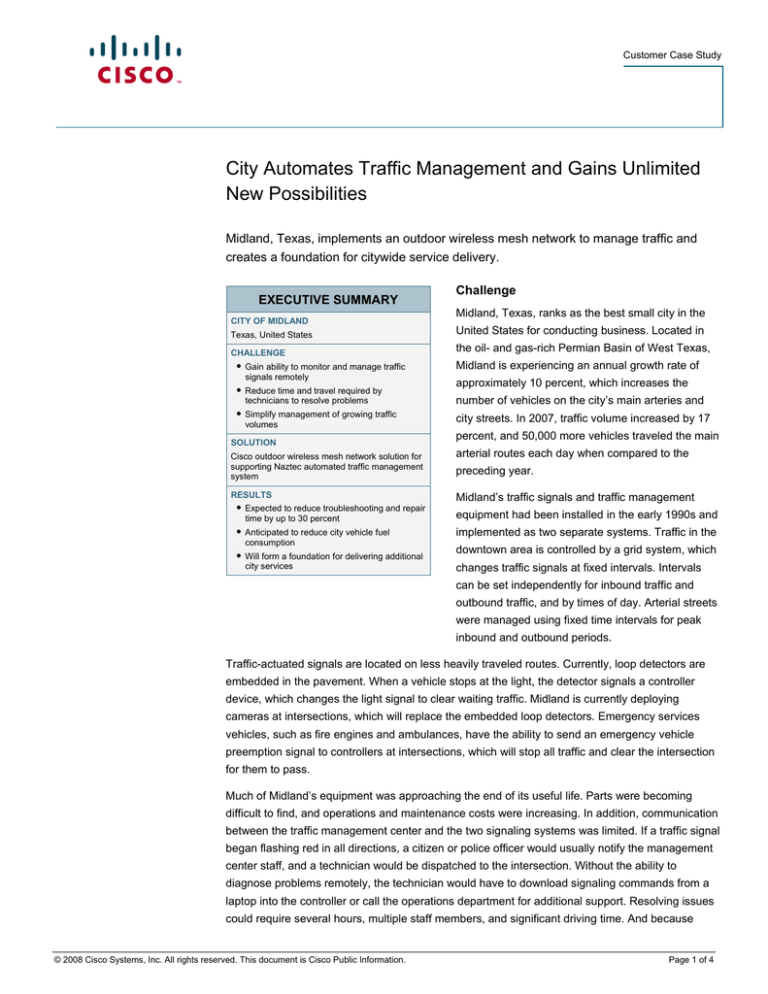
Customer Case Study
City Automates Traffic Management and Gains Unlimited
New Possibilities
Midland, Texas, implements an outdoor wireless mesh network to manage traffic and
creates a foundation for citywide service delivery.
EXECUTIVE SUMMARY
CITY OF MIDLAND
Texas, United States
CHALLENGE
● Gain ability to monitor and manage traffic
signals remotely
● Reduce time and travel required by
technicians to resolve problems
● Simplify management of growing traffic
volumes
SOLUTION
Cisco outdoor wireless mesh network solution for
supporting Naztec automated traffic management
system
RESULTS
● Expected to reduce troubleshooting and repair
time by up to 30 percent
● Anticipated to reduce city vehicle fuel
consumption
● Will form a foundation for delivering additional
city services
Challenge
Midland, Texas, ranks as the best small city in the
United States for conducting business. Located in
the oil- and gas-rich Permian Basin of West Texas,
Midland is experiencing an annual growth rate of
approximately 10 percent, which increases the
number of vehicles on the city’s main arteries and
city streets. In 2007, traffic volume increased by 17
percent, and 50,000 more vehicles traveled the main
arterial routes each day when compared to the
preceding year.
Midland’s traffic signals and traffic management
equipment had been installed in the early 1990s and
implemented as two separate systems. Traffic in the
downtown area is controlled by a grid system, which
changes traffic signals at fixed intervals. Intervals
can be set independently for inbound traffic and
outbound traffic, and by times of day. Arterial streets
were managed using fixed time intervals for peak
inbound and outbound periods.
Traffic-actuated signals are located on less heavily traveled routes. Currently, loop detectors are
embedded in the pavement. When a vehicle stops at the light, the detector signals a controller
device, which changes the light signal to clear waiting traffic. Midland is currently deploying
cameras at intersections, which will replace the embedded loop detectors. Emergency services
vehicles, such as fire engines and ambulances, have the ability to send an emergency vehicle
preemption signal to controllers at intersections, which will stop all traffic and clear the intersection
for them to pass.
Much of Midland’s equipment was approaching the end of its useful life. Parts were becoming
difficult to find, and operations and maintenance costs were increasing. In addition, communication
between the traffic management center and the two signaling systems was limited. If a traffic signal
began flashing red in all directions, a citizen or police officer would usually notify the management
center staff, and a technician would be dispatched to the intersection. Without the ability to
diagnose problems remotely, the technician would have to download signaling commands from a
laptop into the controller or call the operations department for additional support. Resolving issues
could require several hours, multiple staff members, and significant driving time. And because
© 2008 Cisco Systems, Inc. All rights reserved. This document is Cisco Public Information.
Page 1 of 4
Customer Case Study
technicians are also responsible for maintaining traffic signals, school flasher systems, and
emergency services sirens, routine maintenance projects could be delayed.
Other traffic tasks also had to be managed manually. For example, routing traffic for weekly football
games and special events required driving to the location with a trailer that carries a programmable
message sign. This would have to be hauled out and back for each event.
“In the beginning, I was looking at a traffic signal
system. Once we had the wireless mesh network
component of the solution, potential applications kept
building. Now we are discussing citywide capabilities,
adding transit, and even expanding it regionally. As we
say in Midland, the sky is the limit.”
– Gary Saunders, Transportation Manager, City of Midland
Solution
“I had been looking for a way to implement two-way communication on our systems for several
years,” says Gary Saunders, traffic manager for the City of Midland. “I wanted to be able to send
and receive data, so that we could minimize manual intervention. As I evaluated solutions and
talked with colleagues in other cities, I repeatedly heard about Cisco® solutions combined with
automated traffic management systems.”
Saunders had already chosen traffic control hardware and automated traffic management software
from Naztec, Inc., a leading provider of traffic control systems and traffic engineering services.
Working with Cisco, he developed a plan that would enable him to solve the city’s immediate traffic
management needs, as well as provide a platform for other innovative applications across the city.
Saunders and the city chose the Cisco Aironet® 1520 Series Wireless Broadband Platform as the
foundation for a high-performance outdoor wireless mesh network. Approximately 200 Aironet 1520
Series Platforms will be installed across Midland to create a powerful wireless network that
supports the Naztec automated traffic management system. Naztec software uses the network to
programmatically control all signal lights and pedestrian crossing signals.
The solution is being implemented by Coleman Technologies, Inc., a Cisco Gold Certified Partner
with Master unified communications and security specializations. Coleman Technologies provides
information technology and systems engineering services. Once the network is fully implemented,
Midland can add wireless IP cameras, school zone flashers, or mobile access routers in vehicles,
such as for technicians or emergency services personnel.
Results
Saunders expects the new wireless system to begin delivering benefits immediately. Drivers will
notice less congestion and experience fewer delays due to malfunctioning signals and high traffic
volumes.
“We want to encourage motorists to maintain a consistent speed when traveling through the city,”
says Midland Mayor Wes Perry. “They can expect to drive Midland’s roadways with minimal red
light stops. Texans drive friendly, and Midlanders are no exception.”
© 2008 Cisco Systems, Inc. All rights reserved. This document is Cisco Public Information.
Page 2 of 4
Customer Case Study
The primary traffic management benefit will be improved productivity for technicians. The Naztec
system will notify the traffic management center when a signal malfunctions or has received
conflicting commands. For example, a technician might receive a call that there is a gridlock on an
arterial route. He can pinpoint the location on the automated transportation management system
and quickly identify the problem. Perhaps a controller has lost synchronization, or simultaneous
emergency vehicle preemption calls created a signal conflict. The signaling issue can be remedied
remotely, or in the event of physical equipment or wiring problems, a technician can be dispatched
to the light pole or controller box with the correct tools.
“By having the automated system analyze an issue, I estimate that we will be able to reduce the
amount of time spent on troubleshooting and issue resolution by at least 30 percent,” says
Saunders. “By reducing manual intervention, we can also reduce fuel costs for the city. At the same
time, Midland motorists experience fewer delays, emissions are reduced, and drivers gain
improved fuel mileage. Collectively these savings translate into millions of dollars annually.”
The new system will also simplify implementing traffic monitoring and signage for special events.
Messages can be typed in and automatically displayed across the city at critical signage points,
and traffic flow can be monitored in real time to adjust light intervals or establish detours.
One of the most significant benefits to Midland, however, will be the ability to build applications on a
robust, wireless, multiservice platform that will support future applications benefiting a wide range
of departments. Saunders is evaluating a video monitoring application that will enable him to
monitor critical intersections for abnormal traffic congestion and adjust signals as needed or notify
police of an accident.
Implementing its automated traffic light management system on Cisco’s wireless network is
Midland’s first step toward achieving a Cisco Open Platform for Safety and Security; a platform on
which Cisco and partner technology come together using open standards to deliver unprecedented
innovation for a safer, more secure, and efficient city. The Cisco Open Platform for Safety and
Security will enable the same wireless network that serves traffic management to also enable the
city to implement security cameras in school districts. In addition, Midland-based drilling and
refinery operations can employ wireless transport as part of their business continuity and disaster
recovery plans.
Mobile access routers can also be installed in police and fire vehicles, providing access to vital
information, streaming video, and communication resources anywhere in the city through a
common operating view. By using Mobile Ad Hoc Networking capabilities, which enable mobile
nodes to associate on an on-demand basis, responders have access to critical data, real-time
visibility, and situational awareness.
Potentially, the network could connect with the fiber and copper communications infrastructure that
already is deployed along major regional traffic routes. Overlaying the wireless mesh network with
existing fiber and copper creates a backbone infrastructure that enables mobility for every city and
county emergency responder vehicle.
Next Steps
The new automated system is expected to be fully implemented in January 2009. Next, Saunders
plans to install mobile access routers in maintenance trucks for delivering work orders and
eliminating excess driving between the office and repair sites.
© 2008 Cisco Systems, Inc. All rights reserved. This document is Cisco Public Information.
Page 3 of 4
Customer Case Study
“In the beginning, I was looking at a traffic signal system,” says Saunders. “Once we had the
wireless mesh network component of the solution, potential applications kept building. Now we are
discussing citywide capabilities, adding transit, and even expanding it regionally. As we say in
Midland, the sky is the limit.”
For More Information
To find out more about Cisco solutions and services, visit: www.cisco.com.
To learn more about the City of Midland, visit www.ci.midland.tx.us.
This customer story is based on information provided by the City of Midland, and describes how that particular organization
benefits from the deployment of Cisco products. Many factors may have contributed to the results and benefits described;
Cisco does not guarantee comparable results elsewhere.
CISCO PROVIDES THIS PUBLICATION AS IS WITHOUT WARRANTY OF ANY KIND, EITHER EXPRESS OR IMPLIED,
INCLUDING THE IMPLIED WARRANTIES OF MERCHANTABILITY OR FITNESS FOR A PARTICULAR PURPOSE. Some
jurisdictions do not allow disclaimer of express or implied warranties, therefore this disclaimer may not apply to you.
Printed in USA
© 2008 Cisco Systems, Inc. All rights reserved. This document is Cisco Public Information.
C36-501320-00 10/08
Page 4 of 4




